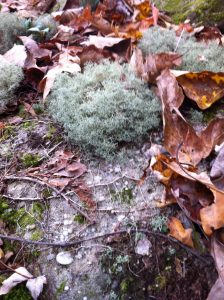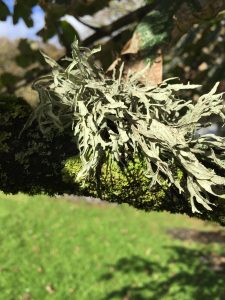
Cladina lichen.
Last weekend, at Whippoorwill festival, i led a group of people into the woods to show them some medicinal lichens. Lichens are simultaneously familiar and alien to most people. They grow nearly everywhere, on rocks and trees and old fenceposts and bare ground, and yet few people have names for them or know much about them.
A lichen is a single organism, consisting of fungal tissue and algal tissue working together. Lichens contain two sets of dna from two distant branches of the family tree of living things. They contain some substances that you might find in medicinal mushrooms like Reishi or Maitake, some substances that you might find in algae like spirulina or chlorella, and some substances that are only found in lichens.
There are many, many types of lichens, some very common and some known only from a single stand in the entire world. Here are a few of the lichens we encountered on our walk in the woods.
Usnea– probably the best known medicinal lichen, one of only a couple used commercially in the western world. Usnea contains lichen acids with a broad spectrum of antiinfective properties, as well as β-glucans that nourish the immune system. It also contains oil-soluble substances that are potent, novel pain relieving substances. Usnea is a stringy, mossy lichen that grows on tree branches.
parmelia and parmotrema– these are the common papery lichens that grow on tree bark and old fenceposts. They have similar antiinfective properties to usnea, and also contain a strong, non-sedating antihistamine.
Cladina– known as deer moss or reindeer moss (two different but possibly overlapping species), cladina grows on the ground in rocky places and in areas where the ground has been exposed by erosion. It often grows under conifers. Cladina is a diuretic, and has traditionally been used to dissolve stones in the kidneys. It’s also quite nutritious (though very acidic) and forms a staple of the diet of barren ground caribou and reindeer.

Evernia (oakmoss) on a tree branch. An Spiddal, Ireland. We didn’t see this one on the walk but it does grow around here. It can be made into a liniment for fungal infections.